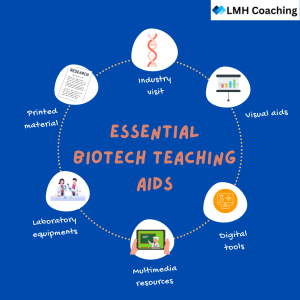What are teaching aids?
Teaching aids are special tools that teachers use to make learning easier and more fun. They help explain things better and include pictures, drawings, videos, and audio. These aids act like superheroes, making lessons exciting and easy to understand for everyone.
What is biotechnology?
Biotechnology, or biotech, uses biology to create new products and methods that improve human health and society. Biotech has been around since ancient times, starting with the domestication of plants and animals and the discovery of fermentation.
Essential Teaching Aids for BioTech Teachers
Teaching biotechnology, a fast-growing field, needs various teaching aids to help students understand complex ideas. This guide covers the key biotech teaching tools to improve your classroom experience.

1.Visual Aids
Visual aids are crucial in teaching biotechnology as they help students visualize complex biological processes.
-
Diagrams and Charts
Using detailed diagrams and charts of cellular processes, DNA structures, and metabolic pathways can greatly help understanding. These visual tools break down complex details into understandable parts.
-
3D Models
3D models of DNA, proteins, and cells provide a tangible understanding of structures that are otherwise too small to see. These models help students grasp the physical dimensions and spatial arrangements of biological molecules.
-
Microscope Slides
Prepared microscope slides displaying various cells and tissues relevant to biotechnology are essential. Observing these slides under a microscope can bridge the gap between theoretical knowledge and practical understanding.
2.Digital Tools
Incorporating digital tools into your teaching strategy can greatly enhance student engagement and learning.
-
Interactive Activities
Interactive activities allow students to explore biological processes like CRISPR gene editing, PCR, and cloning in a virtual environment. These activities can mimic real-life scenarios, providing a hands-on experience without the need for physical materials.
-
Virtual Labs
Virtual labs give students a place to do experiments in a virtual lab setting. These labs are especially useful when resources are limited or for teaching lab safety and procedures before using real equipment.
-
Bioinformatics Tools
Teaching students to use bioinformatics tools like BLAST for sequence alignment and analysis, and accessing databases like GenBank, is crucial. These tools are fundamental in modern biotechnology research and development.
3.Multimedia Resources
Multimedia resources can make learning more engaging and interactive.
-
Educational Videos
Incorporate educational videos such as documentaries and animated explanations of bio-tech concepts. These videos can simplify complex topics and demonstrate real-world applications, making the subject more relatable and interesting.
-
Online Lectures and Tutorials
Offering online classes and tutorials from sites like Khan Academy, Coursera, and YouTube can support your teaching. These resources give different explanations and viewpoints that can help students understand the material better.
4.Laboratory Equipment
Hands-on experience is irreplaceable in biotechnology education.
-
Basic Lab Equipment
Equip your lab with basic equipment like microscopes, centrifuges, PCR machines, and electrophoresis apparatus. These tools are foundational for conducting essential biotechnology experiments.
-
Specialized Equipment
For advanced experiments, specialized equipment such as spectrophotometers, bioreactors, and chromatographs are necessary. These instruments allow students to perform detailed analyses and understand more complex biotechnological processes.
-
Lab Kits
Pre-packaged lab kits for specific experiments, like DNA extraction, gene cloning, and bacterial transformation, are invaluable. These kits provide all the necessary materials and instructions, ensuring that students can conduct experiments safely and effectively.
5.Printed Materials
Despite the digital age, printed materials remain crucial for learning.
-
Textbooks and Reference Books
Up-to-date textbooks and reference books covering biotechnology principles and practices are essential. These resources provide a comprehensive foundation and can be used for both teaching and self-study.
-
Lab Manuals
Lab manuals offering step-by-step guides for laboratory experiments and safety protocols are indispensable. They ensure that students can follow procedures correctly and understand the importance of lab safety.
-
Scientific Journals
Access to scientific journals allows students to stay current with the latest research and developments in biotechnology. Encouraging students to read and discuss journal articles can foster critical thinking and a deeper understanding of the field.
6.Interactive Tools
Engaging students interactively can make learning more effective and enjoyable.
-
Voting device and quick quizzes
Using voting devices and quick quizzes during classes allows for instant quizzes and feedback. This interactive method helps to check if students understand and keeps them engaged in the lesson.
-
Collaborative Platforms
Online collaborative platforms like Google Classroom or Microsoft Teams facilitate group work and discussions. These tools support communication, collaboration, and the sharing of resources among students and teachers.
7.Field Trips and Industry Visits
Real-world exposure is invaluable for biotechnology students.
-
Biotech Companies and Research Institutes
Organizing visits to biotech companies and research institutes gives students insight into the practical applications of biotechnology. These visits can inspire students and provide a clearer picture of potential career paths.
-
Science Museums and Exhibits
Educational trips to science museums and exhibits enhance understanding through interactive displays and demonstrations. These visits can make learning more engaging and fun while reinforcing classroom concepts.
Conclusion
Adding these important biotech teaching tools to your lessons can greatly improve how your students learn. By using a combination of pictures, online tools, videos, lab gear, printed materials, interactive activities, and real-life examples, you can make learning more interesting and enjoyable.
MORE READ:https://lmhcoaching.in/essential-teaching-aids-for-english-teachers/
